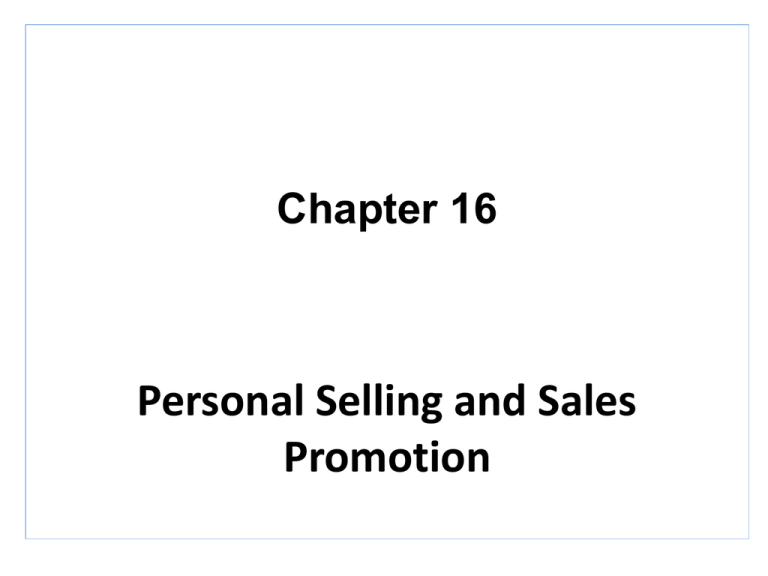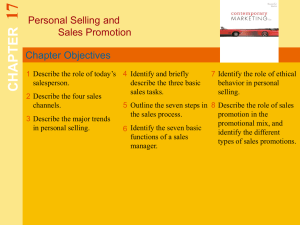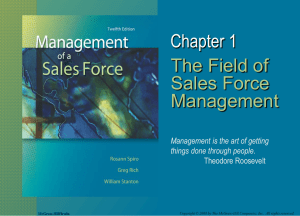The Personal Selling Process
advertisement

Chapter 16 Personal Selling and Sales Promotion Topics to Cover • Managing the Sales Force • The Personal Selling Process • Sales Promotion Managing the Sales Force Other Sales Force Strategy and Structure Issues Outside salespeople call on customers in the field Inside salespeople conduct business from their offices and often provide support for the outside salespeople – Technical sales support people – Sales assistants Team selling is used to service large, complex accounts Managing the Sales Force Recruiting and Selecting Salespeople Issues in Recruiting and Selecting • Careful selection and training increases sales performance • Poor selection • Increases recruiting and training costs – Lost sales – Disrupts customer relationships Managing the Sales Force Salesperson compensation based on: Fixed amounts Variable amounts Expenses Fringe benefits Managing the Sales Force Supervising and Motivating Salespeople • The goal of supervision is to help salespeople work smart by doing the right things in the right ways • The goal of motivation is to encourage salespeople to work hard and energetically toward sales force goals Managing the Sales Force How Salespeople Spend Their Time Managing the Sales Force Selling and the Internet Major tool to support salespeople Training Sales meetings Live sales presentations Servicing accounts Managing the Sales Force Supervising and Motivating Salespeople • Sales morale and performance can be increased through: – Organizational climate – Sales quotas – Positive incentives Managing the Sales Force Evaluating Salespeople and Sales Force Performance Sales reports Call reports Expense reports The Personal Selling Process The goal of the personal selling process is to get new customers and obtain orders from them The Personal Selling Process Steps in the Personal Selling Process Prospecting identifies qualified potential customers through referrals from: • Customers • Suppliers • Dealers • Internet The Personal Selling Process Steps in the Personal Selling Process Qualifying is identifying good customers and screening out poor ones by looking at: • Financial ability • Volume of business • Needs • Location • Growth potential The Personal Selling Process Steps in the Personal Selling Process Pre-approach is the process of learning as much as possible about a prospect, including needs, who is involved in the buying, and the characteristics and styles of the buyers Objectives • Qualify the prospect • Gather information • Make an immediate sale Approaches • Personal visit • Phone call • Letter The Personal Selling Process Steps in the Personal Selling Process Approach is the process where the salesperson meets and greets the buyer and gets the relationship off to a good start and involves the salesperson’s: • Appearance • Opening lines • Follow-up remarks The Personal Selling Process Steps in the Personal Selling Process • Opening lines should be positive, build goodwill, and be followed by key questions to learn about the customer’s needs or showing a display or sample to attract the buyer’s attention and curiosity • The most important attribute is for the salesperson to: listen The Personal Selling Process Steps in the Personal Selling Process Presentation is when the salesperson tells the product story to the buyer, presenting customer benefits and showing how the product solves the customer’s problems • Need-satisfaction approach: Buyers want solutions and salespeople should listen and respond with the right products and services to solve customer problems The Personal Selling Process Steps in the Personal Selling Process Bad Traits Pushy Late Disorganized Deceitful Unprepared The Personal Selling Process Steps in the Personal Selling Process Good Traits Good listeners Dependable Empathetic Honest Thorough Follow-up types The Personal Selling Process Steps in the Personal Selling Process Handling objections is the process where salespeople resolve problems that are logical, psychological, or unspoken The Personal Selling Process Steps in the Personal Selling Process Closing is the process where salespeople should recognize signals from the buyer—including physical actions, comments, and questions—to close the sale The Personal Selling Process Steps in the Personal Selling Process Follow-up is the last step in which the salesperson follows up after the sale to ensure customer satisfaction and repeat business The Personal Selling Process Personal Selling and Managing Customer Relationships Personal selling is transaction-oriented to close a specific sale with a specific customer • The long-term goal is to develop a mutually profitable relationship Sales Promotion Sales promotion refers to the short-term incentives to encourage purchases or sales of a product or service: – Consumer promotions – Trade promotions – Sales force promotions Sales Promotion Factors in the Growth of Sales Promotions • Product managers are under pressure to increase current sales • Companies face more competition • Competing brands offer less differentiation • Advertising efficiency has declined due to rising costs, clutter, and legal constraints • Consumers have become more deal-oriented Sales Promotion Sales Promotion Objectives • Setting sales promotion objectives includes using: – Consumer promotions – Trade promotions – Sales force promotions Sales Promotion Major Sales Promotion Tools Samples Coupons Cash refunds Price packs Premiums Advertising specialties Patronage rewards Point-ofpurchase displays Demonstrations Contests Sweepstakes Games Sales Promotion Major Sales Promotion Tools Consumer Promotion Tools Samples offer a trial amount of a product Coupons are certificates that give buyers a saving when they purchase specified products Cash refunds are similar to coupons except that the price reduction occurs after the purchase Price packs offer consumers savings off the regular price of a product Sales Promotion Major Sales Promotion Tools Consumer Promotion Tools Premiums are goods offered either for free or at low price Advertising specialties are useful articles imprinted with the advertiser’s name, logo, or message that are given as gifts to consumers Point-of-purchase promotions include displays and demonstrations that take place at the point of sales Sales Promotion Major Sales Promotion Tools Consumer Promotion Tools Contests, sweepstakes, and games give consumers the chance to win something—such as cash, trips, or goods—by luck or through extra effort • Contests require an entry by a consumer • Sweepstakes require consumers to submit their names for a drawing • Games present consumers with something that may or may not help them win a prize • Event marketing Sales Promotion Major Sales Promotion Tools Trade Promotion Tools Discount Allowance Free goods Specialty advertising Sales Promotion Major Sales Promotion Tools Business Promotion Tools Conventions and trade shows are effective to reach many customers not reached with the regular sales force Sales contests are effective in motivating salespeople or dealers to increase performance over a given period Sales Promotion Developing the Sales Promotion Program • • • • • Size of the incentive Conditions for participation Promote and distribute the program Length of the program Evaluation of the program








